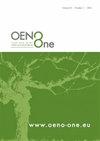消费者对受烟雾影响的葡萄酿造的葡萄酒的反应
IF 2.2
3区 农林科学
Q3 FOOD SCIENCE & TECHNOLOGY
引用次数: 1
摘要
当葡萄园和葡萄暴露在野火或受控燃烧的烟雾中时,这可能会导致葡萄酒具有烟熏、烧焦或灰蒙蒙的特性,这与挥发性酚类和酚苷浓度升高有关。这些烟熏味被酿酒师认为是不受欢迎的,但关于消费者对受烟熏影响的葡萄酒的反应,几乎没有信息。为了调查消费者在盲目品尝葡萄酒时是否会对烟熏味产生负面反应,进行了三项研究,评估了黑皮诺桃红葡萄酒、霞多丽葡萄酒和未烘焙的设拉子葡萄酒的烟熏味。总体而言,与未受烟雾影响的葡萄酒相比,被评为烟雾味较高的葡萄酒不太受欢迎。与葡萄酒类型无关,烟熏味与消费者整体喜好之间存在强烈的负相关。详细的数据分析显示,饮酒的消费者分为三类:对烟雾反应强烈、反应中等或少数无反应者。这些基于消费者的信息对于指导评估葡萄烟雾暴露的风险和葡萄酒质量缺陷的可能性,以及为葡萄酒生产商确定和基准管理选项至关重要,不仅在澳大利亚,而且在全球范围内。本文章由计算机程序翻译,如有差异,请以英文原文为准。
Consumer response to wine made from smoke-affected grapes
When vineyards and grapes are exposed to smoke from wildfires or controlled burns, this can result in wines with smoky, burnt or ashy attributes that have been linked to the presence of elevated concentrations of volatile phenols and phenolic glycosides. These smoky flavours are considered undesirable by winemakers, but there is little information about how consumers respond to smoke-affected wines. To investigate whether consumers respond negatively to smoky attributes when wine is tasted blind, three studies assessing sets of Pinot noir rosé, Chardonnay and unoaked Shiraz wines with varied smoke flavour were conducted. Overall, wines rated high in smoke flavour were less liked compared to non-smoke-affected wines. Independent of wine type, there was a strong negative correlation between smoky flavour and overall consumer liking. Detailed data analysis revealed that consumers who are wine drinkers fell into one of three categories: highly responsive to smoke, moderately responsive, or a smaller group of non-responders. This consumer-based information is essential for guiding the assessment of risk from smoke exposure of grapes and potential for quality defects in wine, as well as identifying and benchmarking management options for wine producers, not only in Australia, but globally.
求助全文
通过发布文献求助,成功后即可免费获取论文全文。
去求助
来源期刊

OENO One
Agricultural and Biological Sciences-Food Science
CiteScore
4.40
自引率
13.80%
发文量
85
审稿时长
13 weeks
期刊介绍:
OENO One is a peer-reviewed journal that publishes original research, reviews, mini-reviews, short communications, perspectives and spotlights in the areas of viticulture, grapevine physiology, genomics and genetics, oenology, winemaking technology and processes, wine chemistry and quality, analytical chemistry, microbiology, sensory and consumer sciences, safety and health. OENO One belongs to the International Viticulture and Enology Society - IVES, an academic association dedicated to viticulture and enology.
 求助内容:
求助内容: 应助结果提醒方式:
应助结果提醒方式:


